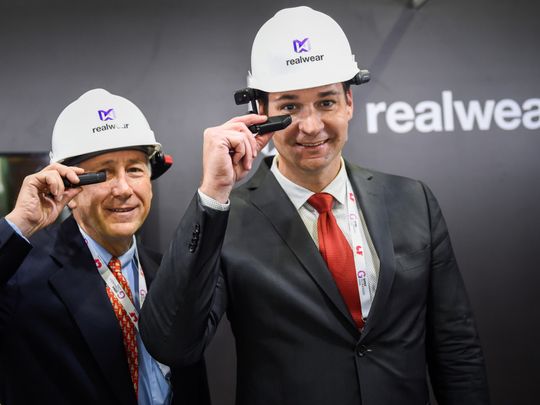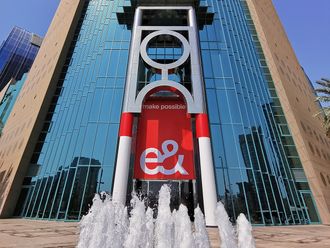
Dubai: Wearable technology is not known for its style, but one company has discovered that for some workers, particularly those who get their hands dirty, function — not form — is a more important factor.
RealWear, based in the US, isn’t focused on consumers. Instead, it is making a wearable tech device, called the HMT-1, for industrial workers, particular those working in oil and gas, energy, transportation, manufacturing, and even the medical field.
“I have no consumer desires or plans,” said CEO Andy Lowery. “I’m 100 per cent B2B, 100 per cent industry, unlike a lot of my partners in the space.”
Lowery, who was in Dubai for Gitex Technology Week at the Dubai World Trade Centre, gave Gulf News a demonstration of the Android-based device. The HMT-1, which can be fitted to a hard-hat, wraps around the head and has a miniature heads-up display on an adjustable arm, which can be moved in or out of your line of sight. It is voice activated, connects over WiFi, has a slot for an SD card, and has a built-in 16 megapixel camera with a flashlight. It’s not going to make you look cool, but since the device is meant for industrial workers, it is rugged enough to be thrown in the back of a truck with the other tools. Lowery is not shy about tossing the device around at his both.
The device is power by Qualcomm’s Snapdragon 626 processor, but Lowery said the company is moving to Qualcomm’s XR1 system, a processor designed for augmented reality and virtual reality devices. Qualcomm is also an investor in RealWear.
While the device has no retail price, Lowery said a single unit would probably sell for around $2,000 (Dh7,340), although enterprise sales bring the price on the most basic version of the HMT-1 as low as $1,400, the same price as a smartphone or a rugged tablet.
Lowery said the HMT-1 is similar to Google Glass, which, although it was taken off the market as a commercial device, is still available as an enterprise device.
“We’re very compatible with Google Glass, but Google Glass is not rugged. It’s not water proof. It’s not outdoor robust,” Lowery said.
Unless Google Glass, which made more headlines for its ability to take sneaky photos in bars, RealWear’s devices are meant to replace laptops, smartphones and tablets in the field.
“This is a computer,” Lowery said. “People forget that all the time. You can use it as your laptop, you can use it a work device.”
In the demo for Gulf News, Lowery walked me through the process of how a worker would “tell” the device to bring up a blueprint, scan the document for the relevant areas, and then zoom in so the worker can have a picture of what he or she was working on while keeping their hands free.
“The voice interface is very robust against noise,” Lowery said. “You can use your voice [to control the device] all the way up to 100 decibels. In fact, it works better with a little noise in the background because of how the signal processing works. So around heavy machinery or jet engines, where you can barely hear yourself speak, the system can still pick up your voice out of the noise.”
RealWear customises the HMT-1 for each specific industry. The oil and gas version of the device, for example, has been designed to safely go anywhere on an oilfield. Lowery said there is no threat of a spark, which could cause an explosion, a concern that keeps a lot of other devices out of the field.
Lowery, who previously was in the US Navy and was a chief engineer at Raytheon, said the company is just entering the Middle East, where the company is speaking to aviation and oil and gas companies. Lowery said the company has done a few pilot programmes with Saudi Aramco.
RealWear devices currently operate in over 60 countries with over 25,000 units already in operation.
“If you want to scale, or get beyond the innovation labs, you have to be global out of the gate. As a start up its one of the most challenging this to do, to create a small company that has a presence globally.”
Lowery said the next version on the device will be hyper-modular, so when companies want to upgrade the device, they can update individual components instead of the whole device.
RealWear was established in 2016 and has been in mass production since 2018. The company raised $80 million in its latest round of funding, Lowery said, bringing its total funding to over $100 million. Major investors were Teradyne, a developer and supplier of automatic test equipment, Bose, the audio equipment manufacturer, Qualcomm, and JP Morgan.












